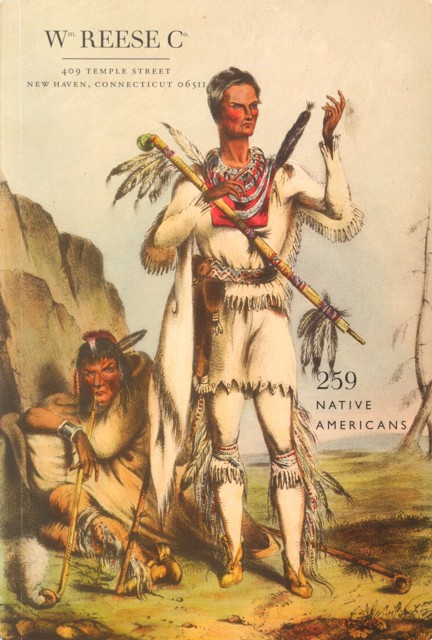<i>Native Americans </i>from the William Reese Company

<i>Native Americans </i>from the William Reese Company
By Michael Stillman
The 259th catalogue from the William Reese Company of New Haven has arrived. It is titled Native Americans. For convenience, we will refer to these people as "Indians," as this is the name the natives were given in antiquity, though this makes about as much sense as calling them Pakistanis. Almost all of these works were written by settlers or Europeans, so the bias is frequently evident, though many writers were at least sympathetic to their plight. It can be difficult to look back at this era of American history as many of these works relate to treaties and other relationships between whites and Indians, filled with promises we now realize were almost always destined to be broken. Sometimes the Indians fought back, other times they attempted to cooperate, but in the end, the result was always the same.
This catalogue includes many examples of two of the most noted areas of Indian collecting -- Indian captivities, and religious tracts in native languages. Captivities, tales of horror by whites captured by Indians, sometimes accurate, other times invented, made popular reading in the 19th century, and helped to justify, in settlers' minds, their own cruelties. On the other side were the missionaries, well-meaning if not culturally sensitive, trying to save the natives from their heathen beliefs. We won't focus on these, but instead, here are a few of the other items Reese is offering in the pages of this catalogue.
From the first days of the Spanish conquests of the New World, the natives suffered terrible mistreatment. In the earliest days, many were made slaves, and few voices spoke out about this injustice. Bartoleme de las Casas was an exception. Las Casas was a Spanish priest who spent most of the years from 1502-1547 in the Caribbean and Mexico, becoming increasingly vocal and vehement in his condemnation of the cruelties perpetrated on the Indians by the Spanish. He continued to voice his opposition on returning to Spain, and while he was unable to make life wonderful for the Indians, he at least was able to bring about some reforms in their treatment. After returning to Spain, he engaged in a debate with another priest, Juan Gines de Sepulveda, who took a less beneficent view toward the Indians and black slaves. There were nine tracts of de las Casas' side of the debate published. Items 115-117 are the fifth, third, and sixth, all published in 1552, priced at $12,500, $12,500, and $9,500.
The first major war between American Indians and settlers began in 1675, and by 1676, the natives had been effectively removed as a major force in New England. The confrontation is known as King Philip's War, King Philip being another name for Wampanoag Chief Metacomet. The expanding settlement of eastern Massachusetts, which began with the arrival of the pilgrims in 1620, led to conflicts along the settlements' edges. In time this escalated to all out war, and in a preview of what would happen over and over for the next two centuries, the Indians were overwhelmed and pushed back into interior lands. Item 132 is Reverend Increase Mather's account, A Brief History of the War with the Indians in New England…When Philip, alias Metacomet…was Slain. This is the first English edition of 1676. With the Indians routed, Mather and his son Cotton could focus on more pressing threats, like witches. $20,000.